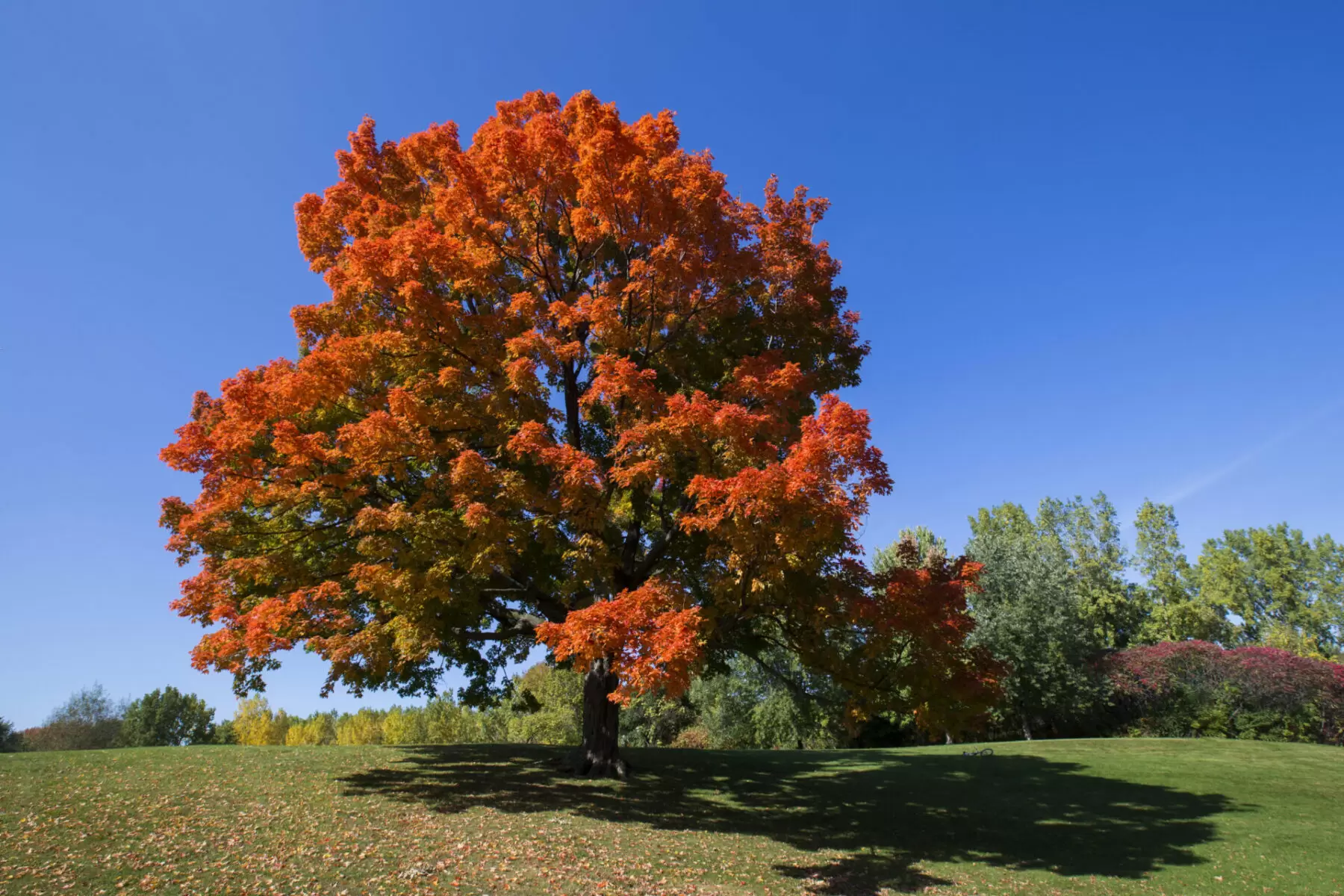
Written by s • Types of Maple Trees
Right in the center of the Canadian flag is a big red leaf – a maple leaf. Canadians have taken the maple tree to their hearts, but they certainly don’t have the monopoly on these beautiful deciduous trees that are renowned throughout the north-east for their flaming fall display. This show attracts millions every year from around the world, but there is more to maples than fall color. A whole industry revolves around the collection of their spring sap, the world’s finest guitars and stringed instruments are made from maple and most baseball bats are a fine piece of maple wood.
How Can You Recognize a Maple Tree?
Maple trees can be identified by several features at different times of year. A simple feature is that the leaves and buds are in pairs, on opposite sides of the stem. The leaves are nearly always laid out like the palm of a hand, with veins radiating up the leaf, leading into lobes that vary in number from three to nine or sometimes more. There is usually one central lobe to the leaf. In fall another absolute feature is the seeds. These are always in pairs, but separate on falling into a wing-like object called by botanists a samara. At one end is the seed, and the wings twirl as they fall like a miniature helicopter, to the delight of small children.
Maple tree are usually large trees, growing up to 150 feet in height, although most are much smaller and some Japanese Maple are even seen as tiny miniature specimens growing in pots as bonsai. There are about 125 different species growing all around the Northern Hemisphere, with 13 in North America and just one growing below the equator, in the Far East. However the popularity of these trees means that there are also many garden varieties, including about 1,000 varieties of Japanese Maple alone.
Maple syrup is probably the most well-known maple product, coming from the spring sap of the Sugar Maple and collected by drilling small holes and putting a pipe in each one, from which the sap drips in spring, when the air is warm and the snow is still on the ground. The sap is then boiled to concentrate the sugars and flavors and is anyone ready for pancakes yet? As syrup and candy it is shipped around the world as a delicacy.
That favorite guitar of yours is probably made of maple too – at least the neck and perhaps the top, like the Gibson Les Paul and many others. Violins, cellos and double basses too are made from maple wood, which transmits sounds perfectly. We mustn’t forget the national sport either, because the Sam Bat is the maple bat used in pro baseball. Maple is also used to make furniture, especially the beautifully patterned pieces known as flame or birdseye maple.
What’s Your Favorite Maple?
Most people know the Sugar Maple best – the centerpiece of the fall fireworks, in shades of orange, red and gold. It is hard to find a better native tree for your yard than this, although the Autumn Blaze Maple can sometimes be a better choice, as this hybrid tree shows reliable vibrant colors, grows rapidly and takes urban conditions better than the Sugar Maple.
There are other native maples, especially the American Red Maple and a special selection of it, called the October Glory Maple, which has the best and most reliable colors, in deep crimsons and scarlet. These trees also make wonderful shade trees, without the hard nuts that can make mowing under some other trees a dangerous sport in fall.
In the west grows the Bigleaf Maple, reaching 100 feet tall with leaves up to a foot across as well as the Rocky Mountain Maple, a small tree that is found wild from Oregon to Nebraska and Arizona.
Pride of place in the maple world must, however, surely belong to the Japanese Maple. Available in many varieties, the most popular are those with red leaves all summer; those with weeping, cascading branches; and those with finely divided leaves like threads, called dissectum. When all three occur together you have a true beauty! The Japanese people have admired and collected these maples for well over a thousand years and the annual outing to see the fall color – called momiji-gari – is not just an excuse for a picnic, but a true spiritual experience. The Japanese Maple is revered, along with the pine, the cherry tree and the sakaki tree.
Because they are so special in the hearts of the Japanese, it is no wonder that any unusual form was collected by admirers, until today we have hundreds of special forms. Some that stand out are the Coral Bark Japanese Maple, with red twigs that brighten the winter days; the Bloodgood Japanese Maple, with reliable red leaves all year; the graceful Green Cascade Japanese Maple the lives up to its name; and the unique Lion’s Head Japanese Maple, with its crowded branches of twisted leaves. Since Japanese Maples are only small trees and often slow-growing, they are ideal choices for smaller gardens, pots and bonsai and grow happily in the shade of larger, native maple trees too.
So whatever your desires, there is a maple tree that will fit perfectly into any garden so that you too can enjoy the special beauty of these fascinating and unique trees.





